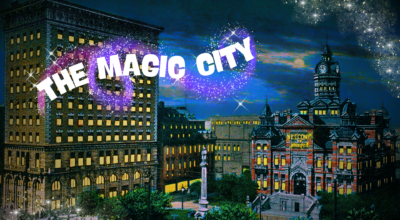
/ Blog
October 25, 2024
Forty and Fabulous: When Buildings Become Heritage
“Everything old is new again,” was supposedly first said by Anglo-Irish author Jonathan Swift, who lived from 1667 to 1745, while others have attributed it to a Chinese proverb. Just as the quote suggests, the old words themselves have faded into obsolescence only to rise in popularity and become new again, with one of its more recent appearances in Stephen King’s 2005 novel, The Colorado Kid. Architecture styles are no different, progressing from fashionable to outdated, and often returning to being in vogue again many years later. Classical architecture of ancient Greece (1200 BCE to 323) and Rome (753 BCE to about 500) inspired the Classical Revival style that rose to prominence in the first couple decades of the 1900s in Canada. Tudor architecture, seen from 1485 to 1558 in England, was also borrowing elements from Classical architecture. It then gave its name to the stylish Tudor Revival, which drew inspiration from late medieval English architecture including that of the Tudor period, becoming prevalent in Canada from 1910 to 1940. Given the many styles of architecture throughout the centuries, the list of revivals goes on and on!
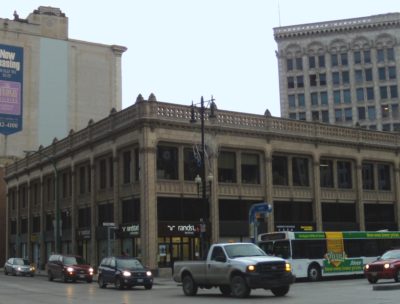
The 1915 Curry Building at 233 Portage Avenue in Winnipeg was built in the Tudor Revival style. Its design draws inspiration from the English Perpendicular Gothic period (about the mid 14th century to the mid 16th century) with some elements, such as columns, found in architecture as far back as ancient Greece.
Source: Ccyyrree, cropped (CC0 1.0 Universal, via Wiki Commons)
This trend cycle creates a paradox for conservation: around the same time a building is becoming heritage and eligible for a protective designation, it is often also being loathed for its tacky style and lack of modern amenities. How do we convince people to save buildings that are currently out of fashion, to hold on to buildings long enough to fall back in love with them? Why not just demolish dated buildings and replace them with modern ones, knowing we can build in the old styles at some later date when the old styles are on trend again? It all begs the bigger question: why save old buildings at all?
Postmodern architecture is currently facing this challenge, passé but prime for heritage designations. The style was a reaction to the minimalist and practical modern architecture of the mid 20th century, instead being rebellious, abstract, fun and colourful. Its irreverent attitude towards history and functionality resulted in a whimsical style with exaggerated features while also being responsive to its environment. Beginning to emerge in the 1960s, the distinctive features of postmodern architecture are often associated with the 1980s and lingered into the 21st century.
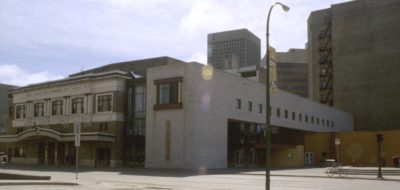
The Pantages Theatre at 180 Market Avenue, seen here on the left, was built between 1913 and 1914. In 1992 it received a postmodern addition, seen here on the right of the original theatre. Noted as “[o]ne of the best examples of Post-modern architecture in Winnipeg” by the Winnipeg Architecture Foundation, the design is a reinterpretation of elements seen in the original part of the theatre.
Source: Winnipeg Building Index – PTSKA-50, cropped (CC BY-NC 3.0, University of Manitoba Libraries)
As postmodern architecture gracefully enters its 40s, much of it is now or will be soon eligible for protection as designated heritage. Both the City of Winnipeg and the Government of Canada agree that a building officially becomes “heritage” on its 40th birthday, meeting the first qualification for designation. A municipal heritage designation in Winnipeg means that along with the building being 40 years or older and having “heritage value”, its character defining elements will be protected from alteration and the building cannot be demolished. Are we ready to acknowledge the heritage value of postmodern architecture and protect it before it is gone?
While it is easy to want to save beautiful heritage buildings with stunning architectural styles that we have grown to appreciate once again, it is harder to embrace the much newer postmodern style. The 1910 Bank of Commerce building at 389 Main Street is an outstanding example of neoclassical architecture inside and out, making it a good poster child for the heritage movement in Winnipeg and one of the first buildings in the city to be designated in 1979. But what about buildings constructed in the 1980s with all the bodacious, fantabulous, radical, tubular and gnarly architecture they have to offer? Unfortunately, it has been observed that there is something about 40 year old buildings that just makes them hard to love. As noted by the award winning Chicago based architectural design educator Stewart Hicks:
It’s like we have a collective blind spot that moves with us like a wake behind a speed boat or a shadow permanently cast behind us 40 years long. There’s just something about architectural design trends, coupled with the lifespan of materials and building systems that goes into this. Those cycles magically overlap at the bottom to render structures and spaces like this especially dated and beyond reasonable repair.
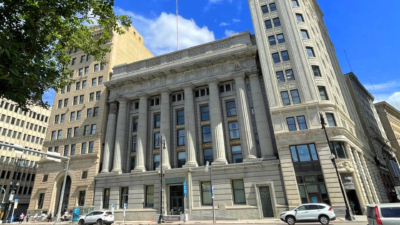
The 1910 Bank of Commerce building at 389 Main Street was saved from proposed demolition and adaptively reused as the Millennium Centre, a stunning event space operated by a non-profit, charitable organization.
Source: Heritage Winnipeg
But there are many reasons to love postmodern architecture and other heritage buildings that go beyond their facades! Conserving built heritage and adaptively reusing it allows our present day communities to reap the benefits from foundations laid decades prior. Firstly, built heritage is a tangible connection to our history. Visible to the public and requiring no admission to admire, these heritage buildings remind us of past people and events, the good and the bad. While the history of some heritage buildings is celebrated, the history of others serves as an important lesson, a reminder of past mistakes and how to do better moving forward. Heritage buildings are also an opportunity for history to be reclaimed, to tell stories that have been forgotten, and to help with the process of reconciliation.

The 1926 Hudson’s Bay Company building at 450 Portage Avenue was gifted to the Southern Chiefs’ Organization on April 22nd, 2022 by the Hudson’s Bay Company. With a long and intertwined history, the transfer of ownership is seen as a step towards economic reconciliation. The planned redevelopment of the building will see it become Wehwehneh Bahgahkinahgohn, providing much needed services for the Indigenous community, including affordable housing, while helping revitalize Winnipeg’s downtown.
Source: Heritage Winnipeg
The economics of built heritage is another valuable reason to save old buildings. It is often more affordable and timelier to adaptively reuse heritage buildings as opposed to embarking on new construction. Additionally, the conservation and maintenance of heritage buildings can require the manufacturing of custom materials and the work specialty craftsmen, creating more local jobs. Ready for occupation, spaces inside built heritage tend to offer more size and price options, ensuring there is a space to fit all kinds of needs and budgets. Revitalized, a heritage building can increase its property value and in turn increase tax revenues, all while encouraging the rejuvenation of the surrounding neighbourhood.
Communities also benefit from the charming character of built heritage which attracts tourists, events, filmmakers and even the technology sector. Heritage Winnipeg’s Doors Open Winnipeg event, a free celebration of Winnipeg’s built heritage, is only possible due to the wonderful collection of heritage buildings in the city. It attracts visitors from near and far while promoting local business and organizations. Winnipeg’s historic Exchange District, filled with warehouses 100 years old or more, is always a popular filming location, but postmodern architecture is also appearing on the silver screen! The 2023 film, The Holiday Shift was shot in downtown Winnipeg’s Portage Place at 393 Portage Avenue, a shopping mall constructed between 1985 and 1987.
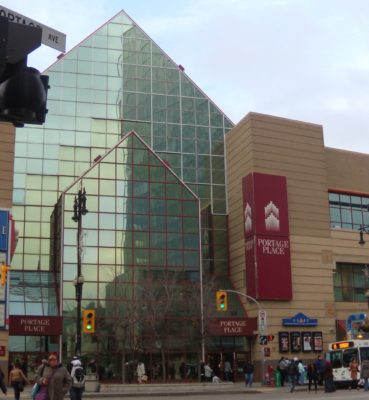
Winnipeg’s Portage Place at 393 Portage Avenue was purchased by True North Real Estate Development in 2024. All three levels of government and the Southern Chiefs’ Organization are involved in a $650 million redevelopment project that will adaptively reuse the postmodern mall to better serve the needs of the community.
Source: Ccyyrree, cropped (CC0 1.0 Universal, via Wiki Commons)
Additionally, saving heritage buildings is good for the environment. It reduces the amount of materials thrown into landfills and the embodied energy (the resources spent making, constructing and maintaining a building throughout its lifetime) lost when a building is demolished. Saving built heritage also requires far fewer new resources to be consumed than a new build, all while conserving the rare materials and custom details found in heritage buildings that are too costly to replicate or no longer available. Making use of existing built heritage in inner cities reduces the need for a city to sprawl outward, taking over greenspaces and large heritage buildings can be subdivided to gently increase the density of neighbourhoods. These strategies maximize the usage of existing infrastructure, again reducing the need for new resources to be used.
Finally, built heritage contributes to vibrant communities with an increased quality of life. Our personal connection with heritage buildings creates a sense of place, a sense of belonging. They are the buildings that have become landmarks in our lives, that are connected to important memories and serve as a visual reminder that we are home. We take pride in our built heritage and feel safe when we stand in its presence, knowing that a constant friend is watching over us. And these are just some of the benefits of saving heritage buildings!
In the coming years, will we be able to see the value in “new” heritage buildings and appreciate their beauty? What will we deem worthy of a protective heritage designation? The award winning office building at 396 Assiniboine Avenue, already age-eligible to be nominated for a heritage designation as it was built in 1978? The avant-garde Holy Ghost Parish Centre at 341 Selkirk Avenue, turning 40 in 2026? The gleaming One Canada Centre at 447 Portage Avenue, stretching skyward since 1987? The geometric stylings of the Royal Winnipeg Ballet at 380 Graham Avenue, reaching heritage age in 2028? Or maybe some other hidden 1980s gem waiting to be discovered?

396 Assiniboine Avenue was built in 1978 as the offices for an architecture firm. The design won the 1982 Governor General’s Medal and the 2000 RAIC Millenium Award.
Source: Winnipeg Building Index – IKOYOIKOY-51 (CC BY-NC 3.0, University of Manitoba Libraries)
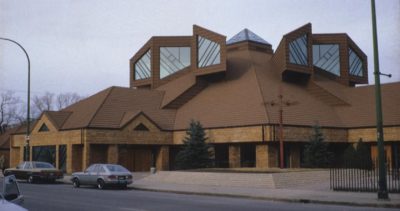
The 1986 Holy Ghost Parish Centre at 341 Selkirk Avenue can trace its roots all the way back to 1899, with the current building replacing the original structure when it was no longer large enough to accommodate the growing congregation.
Source: Winnipeg Building Index – HGCB-52, cropped (CC BY-NC 3.0, University of Manitoba Libraries)
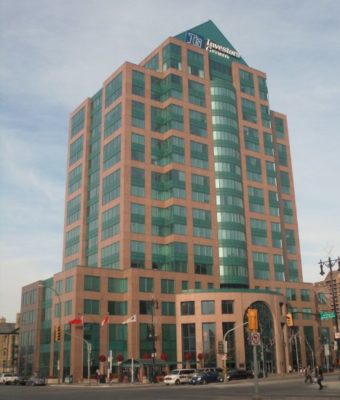
The One Canada Centre at 447 Portage Avenue opened in 1987. It is a bold, 19 storey celebration of coral and green with a clever design that accommodates eight corner offices on each level!
Source: Krazytea, cropped (CC BY-SA 3.0, via Wikimedia Commons)
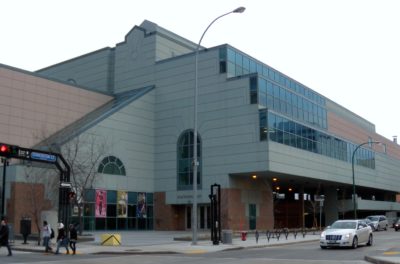
The unmistakable postmodern architecture of the Royal Winnipeg Ballet at 380 Graham Avenue includes references to classical design and terra cotta panels from the Crescent Furniture Building. Once located at the northeast corner of Portage Avenue and Vaughan Street, the 1926 Crescent Furniture Building was demolished in 1985, replaced with Portage Place.
Source: Ccyyrree, cropped (CC0 1.0 Universal, via Wiki Commons)
Postmodern buildings great and small, bland and breathtaking, all have the potential to be tomorrow’s desirable built heritage. While they cannot all become designated heritage, we should still take the time to recognize our subconscious bias against buildings of this age. Let us strive to see the positive contributions postmodern buildings make, hopefully supporting them in leading long and productive lives. For those heritage buildings that do become designated, conservation should then be done in a manner that celebrates what is important about them, allows them to serve their current community and ensures they remain viable for generations to come. Given that most buildings are demolished due to an area being redeveloped or the building becoming functionally obsolete, adaptability is key in designated heritage remaining vibrant and contributing.
Someday, everything old will become new again. The 1980s aesthetic will be rediscovered and revived, and we will celebrate the original architecture of postmodern buildings. We need to look no further than Winnipeg’s Exchange District to see this cycle in action, with great swaths of the area deemed too old and unwanted, set to be demolished as part of the city’s 1965 Cultural Centre Renewal Scheme. Budget constraints limited the destruction and today the neighbourhood is a celebrated National Historic Site, cherished for its early 20th century architecture. It is a reminder that even if we do not like the superficial appearance of a heritage building, it does not mean we should demolish it. Given time, we can learn to appreciate and even celebrate all the different architectural styles that history has to offer. Even 40 year old buildings can be fabulous!
THANK YOU TO THE SPONSOR OF THIS BLOG POST:

Written by Heritage Winnipeg.
SOURCES:
389 MAIN STREET – BANK OF COMMERCE | 1979 - City of Winnipeg
396 Assiniboine Avenue | Winnipeg Architecture Foundation
ancient Greek civilization | Simon Hornblower - Encyclopedia Britannica
Architectural Styles | Heritage Manitoba
Building Styles: Post Modern (1960 - 2009) | Ontario Architecture
The Colorado Kid | Stephen King - 2005
Curry Building | Canada’s Historic Places - Parks Canada
Everything Old Is New Again - A Voice from History | Wes Morgan - July 14, 2019 - Daily Kos
Gothic revival in architecture | Royal Institute of British Architects
Heritage evaluation | November 19, 2022 - Government of Canada
Holy Ghost Parish Centre | Winnipeg Architecture Foundation
Jonathan Swift | Poetry Foundation
List of Historical Resources | City of Winnipeg
Nominate or de-list a Historical Resource | City of Winnipeg
One Canada Centre | Winnipeg Architecture Foundation
Pantages Theatre | Winnipeg Architecture Foundation
Portage Place | Winnipeg Architecture Foundation
Reclaiming History & Culture: Remembering People, Places & Things | Beck Cultural Exchange Center
Royal Winnipeg Ballet | Winnipeg Architecture Foundation
Tudors: Architecture | English Heritage
Tudor Revival Style 1890 - 1920 | Pennsylvania Historical & Museum Commission
Tudor style | The Editors of Encyclopaedia - Encyclopedia Britannica
Why Everything from 1983 Looks Awful | Stewart Hicks - October 5, 2023 - YouTube
Why Preserve? | Calgary Heritage Initiative







